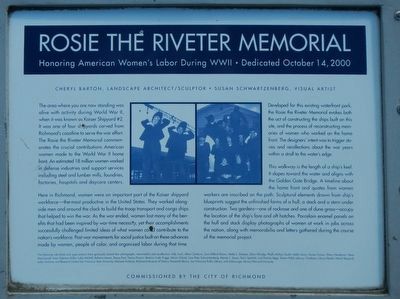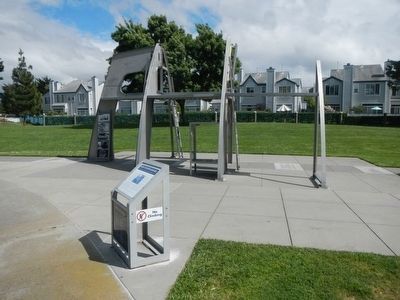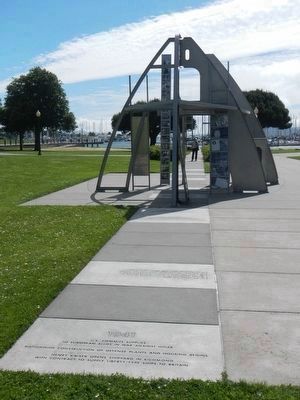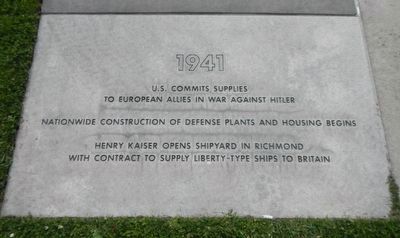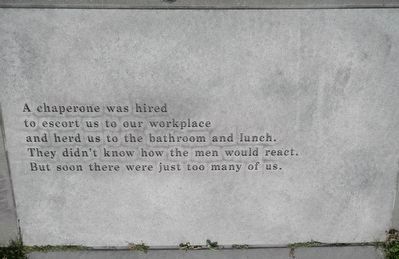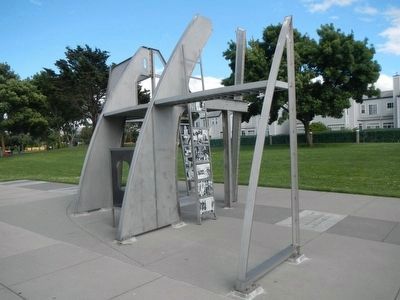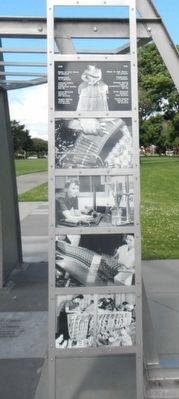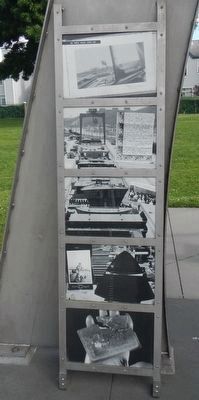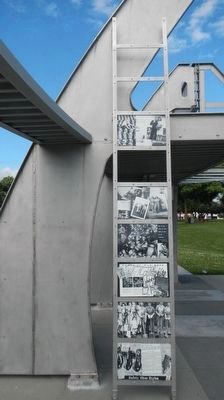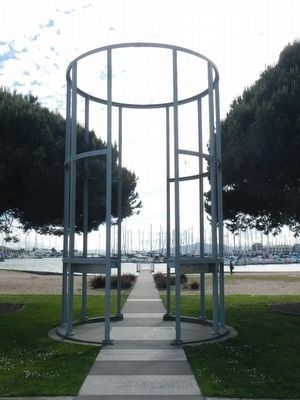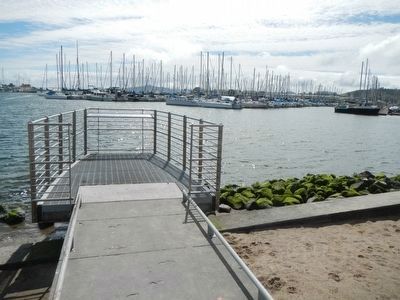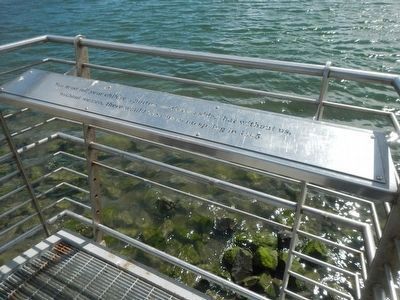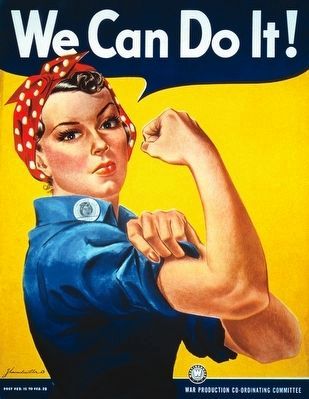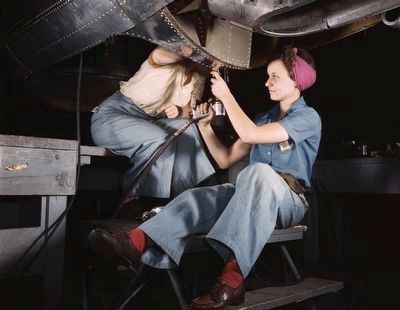Richmond in Contra Costa County, California — The American West (Pacific Coastal)
Rosie the Riveter Memorial
Honoring American Women's Labor During WWII
Here in Richmond, women were an important part of the Kaiser shipyard workforce -- the most productive in the United States. They worked along-side men and around the clock to build the troop transport and cargo ships that helped to win the war. As the war ended, women lost many of the benefits that had been inspired by war-time necessity, yet their accomplishments successfully challenged limited ideas of what women could contribute to the nation's workforce. Post-war movements for social justice built on these advances made by women, people of color, and organized labor during that time.
Developed for this existing waterfront park, the Rosie the Riveter Memorial evokes both the act of constructing the ships built on this site, and the process of reconstructing memories of women who worked on the home front. The designer's intent was to trigger stories and recollections about the war years within a stroll to the water's edge.
This walkway is the length of a ship's keel. It slopes toward the water and aligns with the Golden Gate Bridge. A timeline about the home front and quotes from women workers are inscribed on the path. Sculptural elements drawn from ship's blueprints suggest the unfinished form of a hull, the stack and a stern under construction. Two gardens -- one of rockrose and one of dune grass -- occupy the location of the ships fore and aft hatches. Porcelain enamel panels on the hull and stack display photographs and letters gathered during the course of the memorial project.
(Timeline, bow to stern)
U.S. commits supplies to European Allies in war against Hitler
Nationwide construction of defense plants and housing begins
Henry Kaiser opens shipyard in Richmond with contract to supply Liberty-type ships to Britain
Widespread opposition to hiring women and minority workers
Black leaders threaten to organize 50,000 workers in a march on Washington to demonstrate for jobs
Executive Order 8802 bans racial discrimination in defense work
Pearl Harbor attacked
U.S. enters World War II
80,000 women find work in defense plants
1942
FDR builds his "Great Arsenal of Democracy," asking all citizens to join the war effort by "outproducing and overwhelming the enemy"
Workers recruited by press, radio, and film
Henry Kaiser adapts mass-assembly techniques to shipbuilding
Over 1.2 million Southern Black workers migrate north and west for industrial defense jobs.
Heavy industries adopt new skill classifications, channeling women and minorities into the lowest paid jobs
AFL-CIO adopt no-strike pledge during war
Kaiser begins a health-care program for shipyard workers
Bracero program imports workers from Mexico on short-term contracts to work in agriculture
Executive Order 9066 transfers 120,000 people of Japanese descent to internment camps; 70,000 are U.S. citizens
Hitler implements "Final Solution"
1943
FDR freezes wages and prices while calling for increase in production
Industries employ 200,000 people with disabilities
Prisons take on defense work; some states relax child labor laws
Office of War Information launches campaign to promote defense jobs to housewives
"Rosie the Riveter" pop song released
Women compose 60% of Kaiser work force in Portland, Oregon; 24-hour day care provided at 70 cents per day
United Mine Workers strike when pay rates fall behind inflation
Wildcat strikes throughout country demand wages reflect increasing
corporate profits
Race riots over jobs and housing breakout in Detroit, New York, and Los Angeles
1944
Kaiser produces larger, faster Victory ships
Ammunition Explosion at Port Chicago, California kills 320 sailor and dockworkers -- largest industrial accident of the home front
Number of Black workers in industry triples during war
Average weekly wages for factory worker -- men, $55; women, $31
Unions slowly begin to add equal pay for equal work clause to job contracts
Allied invasion of Normandy uses over 700 ships and 4,000 landing craft
G.I. Bill of Rights passes in Congress
1945
Victory in Europe
U.S. drops atomic bombs on Hiroshima and Nagasaki
Victory against Japan
World War II dead: 54.8 million world wide, including civilians
Defense industry demobilizes; massive layoffs, especially of women and minorities
Veterans given priority for post war jobs
Labor force at Richmond Kaiser Shipyard reduced from 90,00 to less than 10,000
Women returning to pre-war jobs experience significant decline in wages
•
I learned to weld, and when they said I was okay, I went to the hiring hall and was run off. You had to belong to the union, and they said, "No women or blacks." I got pretty upset, and went back every day and up to a different window. I was one of the first six women to get hired at pre-fab.
•
A chaperone was hired to escort us to our workplace and herd us to the bathroom and lunch. They didn't know how the men would react. But soon there were just too many of us.
•
Let me tell you this. I was 23. I never had a job. My husband was a electrician. I told him, "I'm going to work, too." He said, "No you're not." That same afternoon I went to the hiring hall.
•
When I got my first paycheck it was $16.80 a week. I was so happy. I struck it on my wall in the bedroom, then in the kitchen. I didn't want to cash it. I thought I was so rich.
•
Remember those blue stamps? You could hardly find meat. Our friends had a lot of children, so we traded shoe rations for meat rations.
•
It was in all the newspapers -- they needed women workers in factories. We all got raises because my boss was afraid we'd quit and get defense jobs.
•
My mother-in-law had already started her family during the war, so she took a job in the Maritime Child Care Center --- where they had shifts
of children coming in. After the war the day-care ladies brought in the union. They started Local 1.
•
My parents worked in the shipyard until the end of the war. Unable to find work, we returned to Arkansas to farm a few more years until going to Michigan to build cars.
•
Everyone was from a different state and a different place and everything. I'm sorry I can't remember anyone's last name...
•
(Located at the 'stern' platform)
You must tell your children, putting modesty aside, that without us, without women, there would have been no spring in 1945.
Erected 2000 by Commissioned by the City of Richmond.
Topics and series. This memorial is listed in these topic lists: Civil Rights • Industry & Commerce • Labor Unions • War, World II • Women. In addition, it is included in the Former U.S. Presidents: #32 Franklin D. Roosevelt series list.
Location. 37° 54.884′ N, 122° 20.798′ W. Marker is in Richmond, California, in Contra Costa County. Memorial is on Esplanade Drive near Melville Square. Touch for map. Marker is at or near this postal address: 1999 Esplanade Drive, Richmond CA 94804, United States of America. Touch for directions.
Other nearby markers. At least 8 other markers are within 2 miles of this marker, measured as the crow flies. The Home Front Legacy (approx. 0.7 miles away); The Ford Assembly Building (approx. 0.7 miles away); "I was truly there and did my part to the end." -- Addie Mae Cance, former shipyard worker (approx. 1.2 miles away); SS Red Oak Victory (approx. 1.2 miles away); Dynamic Wartime Port (approx. 1.2 miles away); War Boomtown (approx. 1.2 miles away); Wartime Changes (approx. 1.2 miles away); Contra Costa College Site (approx. 1.2 miles away). Touch for a list and map of all markers in Richmond.
More about this memorial. This marker/memorial is located in Marina Park.
Also see . . .
1. Rosie the Riveter -- Wikipedia. Rosie the Riveter is a cultural icon of the United States, representing the American women who worked in factories and shipyards during World War II, many of whom produced munitions and war supplies. These women sometimes took entirely new jobs replacing the male workers who were in the military. Rosie the Riveter is commonly used as a symbol of feminism and women's economic power. (Submitted on May 4, 2016, by Barry Swackhamer of Brentwood, California.)
2. Rosie the Riveter, the song --YouTube. With added visuals. (Submitted on May 9, 2016, by Barry Swackhamer of Brentwood, California.)
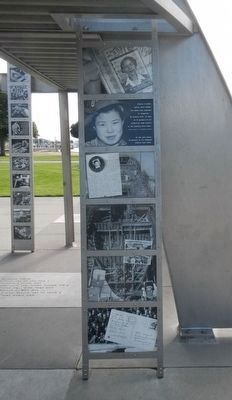
Photographed By Barry Swackhamer, April 22, 2016
9. Rosie the Riveter Memorial
Click on this image to enlarge it and view the panels.
Caption: Nearly 5 months before Pearl Harbor few women were employed in shipyards... By January 1944, as many as 10 percent of all production wage earners in the industry were women. On the west coast, 25 percent of all shipyard workers were women.
Caption: Nearly 5 months before Pearl Harbor few women were employed in shipyards... By January 1944, as many as 10 percent of all production wage earners in the industry were women. On the west coast, 25 percent of all shipyard workers were women.
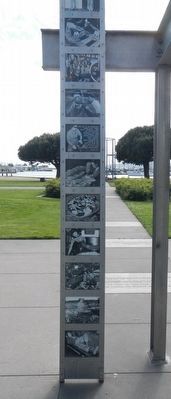
Photographed By Barry Swackhamer, April 22, 2016
10. Rosie the Riveter Memorial
Click on this image to enlarge it and view the panels.
Caption: They are in the shipyards, lumber mills, steel mills, foundries. They are electricians mechanics, and even boilermakers. They operate streetcars, buses, cranes and tractors. Women engineers are working in the drafting rooms and women physicists and chemists in the great industrial laboratories.
Caption: They are in the shipyards, lumber mills, steel mills, foundries. They are electricians mechanics, and even boilermakers. They operate streetcars, buses, cranes and tractors. Women engineers are working in the drafting rooms and women physicists and chemists in the great industrial laboratories.

Photographed By Barry Swackhamer, April 22, 2016
13. Panels on the starboard side of the 'stack'
Click on this image to enlarge it and view the panels.
Panel captions (right to left): I have not been on a ship since... No, definitely not. I will not ride one, I was fearful. When you were working, you would always think about how this ship was going to go out, and who was going to be on the ship when it came back -- the boys in the service. This is what you would fear. You would not want to make an awkward weld. You had to make it perfect -- there were lives involved. The ships had to come back. It wasn't the work that made me fearful. It was the fear of people not coming back. It was what the ship was going to do ... bring back boys and bodies -- that's what the memory goes through.; My mother's first shipyard job was in plate layout. Later she became the first female inspector. She tells a lot of stories, mostly about the guys who gave her a hard time for being a woman. She went on to work for unions. She fought for peace, civil rights, and a living wage. She often says, "Many remember those times with a rosy haze over their riveter eyes -- but we fought hard for social justice!'; It took many years for the small white scars to go away, from the hot rolling slag that fell as I welded overhead.; I weighed 110 lbs, so it was my job -- the flagpole and the double bottom. Yes, I went up to the flagpole, the very top of the ship to weld. Then I went all the way down to the bottom deck. You squeeze through a little hole that goes down; you drag you line, you tools, everything goes down with you, and it's dark... So this is how I worked, from the flagpole to the lowest deck.
Panel captions (right to left): I have not been on a ship since... No, definitely not. I will not ride one, I was fearful. When you were working, you would always think about how this ship was going to go out, and who was going to be on the ship when it came back -- the boys in the service. This is what you would fear. You would not want to make an awkward weld. You had to make it perfect -- there were lives involved. The ships had to come back. It wasn't the work that made me fearful. It was the fear of people not coming back. It was what the ship was going to do ... bring back boys and bodies -- that's what the memory goes through.; My mother's first shipyard job was in plate layout. Later she became the first female inspector. She tells a lot of stories, mostly about the guys who gave her a hard time for being a woman. She went on to work for unions. She fought for peace, civil rights, and a living wage. She often says, "Many remember those times with a rosy haze over their riveter eyes -- but we fought hard for social justice!'; It took many years for the small white scars to go away, from the hot rolling slag that fell as I welded overhead.; I weighed 110 lbs, so it was my job -- the flagpole and the double bottom. Yes, I went up to the flagpole, the very top of the ship to weld. Then I went all the way down to the bottom deck. You squeeze through a little hole that goes down; you drag you line, you tools, everything goes down with you, and it's dark... So this is how I worked, from the flagpole to the lowest deck.
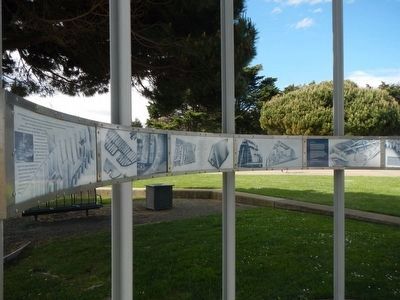
Photographed By Barry Swackhamer, April 22, 2016
14. Panels on the port side of the 'stack'
Click on this image to enlarge it and view the panels.
Panel Captions (left to right): Well all these ladies from Nebraska and Kansas, and you wonder how these ships came out? Well, I spent 9 years in the Merchant Marines. At first, we didn't want to go aboard. You see, the first ships were riveted and this was a new concept -- welding. Some of them cracked apart. But I did get on one that was built here. We went all over the place. Calcutta, Cuba, Melbourne, Ceylon, South Africa, Rio de Janeiro, Trinidad, New Orleans .. We got into some seas with 40-foot waves that cupped the deck like washboards and wiped away some of the lifeboats. Then we got into some uncharted waters and hit a reef -- it ripped out most of the whole double bottom. I don't know how many hours we were stuck on the reef. Then a huge wave knocked us off. We broke radio silence and they sent a tug and towed us 600 miles. If it hadn't been for that double bottom, I wouldn't be here today. So anyway, those ships were built okay ladies!; My doctor assured me that I didn't have the body structure -- ha! We tacked the beams to the bulkhead. I always liked outdoor work better than cooking and housework.; When they launched a ship it didn't have an engine. They would bring it over to the outfitting dock and fit it with everything human beings would need. People were like ants -- they were everywhere, and there were things all over the place that could burn or hurt you. You had to be very careful. Sometimes you would get there flash burns in you eyes, or sparks would fall into your collar or shoes. We wore goggles, but sometimes I wrapped extra scarves around my neck and wrists. I still have scars from those burns.; Dear Ms. Powers: Recently I read an article in our local newspaper regarding the ROSIE the Riveter Memorial. I was quite interested in the article as my mother worked as a welder in the shipyard in Richmond during World War II. I can remember her going to work and taking my brother and me to day care every day. She would be upset because she had to leaver us. My father worked in the same shipyards and they went together. I can remember her in her welding leathers and helmet. I have several newspapers from that time period that my mother saved. If at all possible, could you include my mother's name on the memorial? I think this is a wonderful thing you are doing. These ladies need recognition for what they did to support the war effort. Her name was: DEATA PRIDEMORE My mother passed away in 1979 at age 61. Thank you; Work Description: (Dates, Type of Work...) Draftsman - August 1943-August 1944 I was recruited in Aug. 1943 by Kaiser representatives of Yard 3, after completing a special "crash course" in Drafting at UC Berkeley. I worked on the Outfitting Dock. My initial job was to change blueprints to reflect revisions already made on the first ships that left the yard, and sometimes went with Maritime Inspectors aboard ship to check areas where improvements could be made. There were constant changes as more efficient methods of shipbuilding were found, and I changed the blueprints as they came. I worked one full year (Aug. 1943 - Aug. 1944) until impending Motherhood made that first BIG step up on the Key System impossible. I left the ranks of women shipyard workers and joined a more normal existence as wife of a Serviceman, Mother and homemaker. Back to Bobby sox and dresses!
Panel Captions (left to right): Well all these ladies from Nebraska and Kansas, and you wonder how these ships came out? Well, I spent 9 years in the Merchant Marines. At first, we didn't want to go aboard. You see, the first ships were riveted and this was a new concept -- welding. Some of them cracked apart. But I did get on one that was built here. We went all over the place. Calcutta, Cuba, Melbourne, Ceylon, South Africa, Rio de Janeiro, Trinidad, New Orleans .. We got into some seas with 40-foot waves that cupped the deck like washboards and wiped away some of the lifeboats. Then we got into some uncharted waters and hit a reef -- it ripped out most of the whole double bottom. I don't know how many hours we were stuck on the reef. Then a huge wave knocked us off. We broke radio silence and they sent a tug and towed us 600 miles. If it hadn't been for that double bottom, I wouldn't be here today. So anyway, those ships were built okay ladies!; My doctor assured me that I didn't have the body structure -- ha! We tacked the beams to the bulkhead. I always liked outdoor work better than cooking and housework.; When they launched a ship it didn't have an engine. They would bring it over to the outfitting dock and fit it with everything human beings would need. People were like ants -- they were everywhere, and there were things all over the place that could burn or hurt you. You had to be very careful. Sometimes you would get there flash burns in you eyes, or sparks would fall into your collar or shoes. We wore goggles, but sometimes I wrapped extra scarves around my neck and wrists. I still have scars from those burns.; Dear Ms. Powers: Recently I read an article in our local newspaper regarding the ROSIE the Riveter Memorial. I was quite interested in the article as my mother worked as a welder in the shipyard in Richmond during World War II. I can remember her going to work and taking my brother and me to day care every day. She would be upset because she had to leaver us. My father worked in the same shipyards and they went together. I can remember her in her welding leathers and helmet. I have several newspapers from that time period that my mother saved. If at all possible, could you include my mother's name on the memorial? I think this is a wonderful thing you are doing. These ladies need recognition for what they did to support the war effort. Her name was: DEATA PRIDEMORE My mother passed away in 1979 at age 61. Thank you; Work Description: (Dates, Type of Work...) Draftsman - August 1943-August 1944 I was recruited in Aug. 1943 by Kaiser representatives of Yard 3, after completing a special "crash course" in Drafting at UC Berkeley. I worked on the Outfitting Dock. My initial job was to change blueprints to reflect revisions already made on the first ships that left the yard, and sometimes went with Maritime Inspectors aboard ship to check areas where improvements could be made. There were constant changes as more efficient methods of shipbuilding were found, and I changed the blueprints as they came. I worked one full year (Aug. 1943 - Aug. 1944) until impending Motherhood made that first BIG step up on the Key System impossible. I left the ranks of women shipyard workers and joined a more normal existence as wife of a Serviceman, Mother and homemaker. Back to Bobby sox and dresses!
Credits. This page was last revised on June 16, 2016. It was originally submitted on May 4, 2016, by Barry Swackhamer of Brentwood, California. This page has been viewed 1,188 times since then and 59 times this year. It was the Marker of the Week May 8, 2016. Photos: 1, 2, 3, 4, 5, 6. submitted on May 4, 2016, by Barry Swackhamer of Brentwood, California. 7, 8, 9. submitted on May 8, 2016, by Barry Swackhamer of Brentwood, California. 10, 11, 12, 13, 14, 15, 16, 17. submitted on May 9, 2016, by Barry Swackhamer of Brentwood, California. 18. submitted on May 8, 2016, by J. J. Prats of Powell, Ohio.
